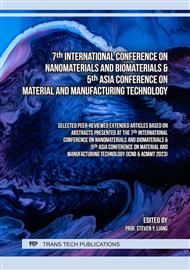[1]
Brian P. Mann, Ben T. Edes, Sam J. Easley, Keith A. Young, and Kong Ma, Chatter vibration and surface location error prediction for helical end mills, International Journal of Machine Tools and Manufacture, Vol. 48, No. 3-4, (2008), pp.350-361.
DOI: 10.1016/j.ijmachtools.2007.10.003
Google Scholar
[2]
Zhou-Long Li, Jin-Bo Niu, Xin-Zhi Wang, and Li-Min Zhu, Mechanistic modeling of five-axis machining with a general end mill considering cutter runout, International Journal of Machine Tools and Manufacture, Vol. 96, (2015), pp.67-79.
DOI: 10.1016/j.ijmachtools.2015.06.006
Google Scholar
[3]
W.Y. Bao, and I.N. Tansel, Modeling micro-end-milling operations. Part II: tool run-out, International Journal of Machine Tools and Manufacture, Vol. 40, No. 15, (2000), pp.2175-2192.
DOI: 10.1016/s0890-6955(00)00055-9
Google Scholar
[4]
T. Insperger, Brian P. Mann, Tobias Surmann, and Gábor Stépána, On the Chatter Frequencies of Milling Processes with Runout, International Journal of Machine Tools and Manufacture, Vol. 48, (2008), pp.1081-1089.
DOI: 10.1016/j.ijmachtools.2008.02.002
Google Scholar
[5]
J. Niu, Y. Ding, L. Min Zhu, and H. Ding, Mechanics and Multi-regenerative Stability of Variable Pitch and Variable Helix Milling Tools Considering Runout, International Journal of Machine Tools and Manufacture, Vol. 123, (2017), pp.129-145.
DOI: 10.1016/j.ijmachtools.2017.08.006
Google Scholar
[6]
N. Ozaki, S. Matsui, T. Hirogaki, and E. Aoyama, Novel State Estimation Method of Surface Chatter Pattern via Image Processing After End Milling, Proceedings of IDETC/CIE2019, ASME, DETC2019-97805, (2019), pp.1-11.
DOI: 10.1115/detc2019-97805
Google Scholar
[7]
T. Hirogaki, E. Aoyama, R. Shiota, and K. Aotani, Control Method of Chatter Vibration Based on Inverse Analysis of End Milling Chatter Mark, Proceedings of the Japan Society for Precision Engineering, Vol. 83, No. 848, (2017), pp.16-00362, (in Japanese).
DOI: 10.1299/transjsme.16-00362
Google Scholar



